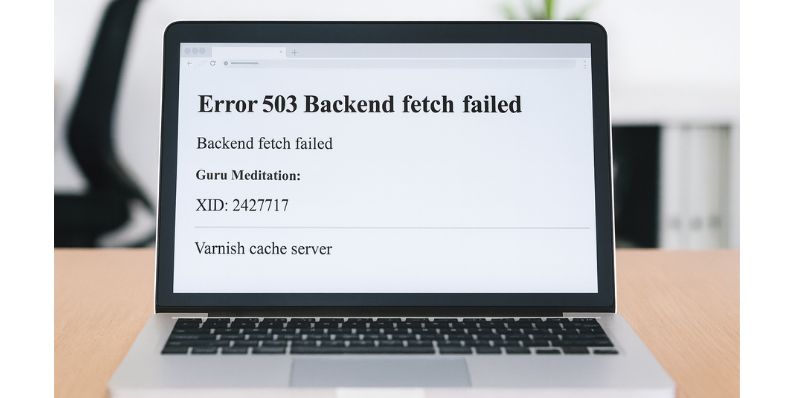How to Fix Error 503 Backend Fetch Failed on Websites and Apps?
You load a website, and instead of the page, you get Error 503 Backend fetch failed. It blocks access to the site, stalls shopping carts, and makes content unreachable. This error can come and go, but when it sticks around, it hurts users and site owners alike. This guide explains what it means, the common causes, fixes, and prevention tips in simple language.
What is Error 503 “Backend fetch failed”?

Error 503 with the note Backend fetch failed is a type of HTTP 503 Service Unavailable response. It happens when a caching layer or reverse proxy, like Varnish Cache, Nginx, or a CDN, tries to fetch content from the backend server but doesn’t get a valid response in time. Instead of serving the requested page, it shows the error.
You’ll see this message as a full error page in the browser. It often appears during heavy traffic, when the backend server is overloaded, or after a deployment when caches are cold. It may also show up on both desktop and mobile browsers if the proxy cannot reach the application server.
Common Causes of Error 503 “Backend fetch failed”
This error usually means the origin server or backend couldn’t respond quickly enough. Some common reasons include:
- Overloaded origin server running out of CPU or memory.
- Too few PHP-FPM, Node.js, or Gunicorn workers to handle concurrent requests.
- Slow database queries or locked tables in MySQL or PostgreSQL.
- Strict Varnish timeout settings like
first_byte_timeoutorconnect_timeout. - Misconfigured health checks or failing backend pool.
- Network or TLS handshake errors between proxy and origin (firewall or security group issues).
- Heavy cache purge or cold cache after a deployment, causing many simultaneous requests.
How to Fix Error 503 “Backend fetch failed”?
Fixes for this error depend on both your caching proxy (often Varnish) and your origin server. The key idea: the proxy asked for content, but the backend didn’t answer properly or in time. Try these fixes step by step.
Fix #1 Verify Origin Server Health
If the backend itself is down, nothing else matters.
Here are the steps you can follow:
- SSH into the origin server or check your cloud provider’s console.
- Run
toporhtopto check CPU and memory usage. - Ensure web services (Apache, Nginx, Node.js, PHP-FPM, etc.) are running.
- Restart services if needed:
systemctl restart nginx,systemctl restart php-fpm. - Reload the site and confirm if the error clears.
Fix #2 Adjust Varnish or Proxy Timeouts
If the backend is slow, the proxy might give up too quickly.
Steps to increase timeout values in Varnish:
- Open the Varnish configuration file (default.vcl).
- Locate
first_byte_timeout,connect_timeout, andbetween_bytes_timeout. - Increase values (e.g., from 15s to 60s for heavy apps).
- Reload Varnish service:
systemctl reload varnish. - Test again by loading the site.
Fix #3 Scale Up Application Workers
Too few workers = bottlenecks.
- For PHP-FPM: increase
pm.max_childreninphp-fpm.conf. - For Node.js: use a process manager like PM2 to run multiple workers.
- For Gunicorn: adjust
--workersbased on CPU cores.
After increasing worker counts, restart the service. This spreads requests across more processes.
Fix #4 Optimize Database Performance
Database bottlenecks often trigger slow responses.
Here are some actions to take:
- Check MySQL/PostgreSQL slow query logs.
- Add missing indexes to heavy queries.
- Optimize queries or break them into smaller ones.
- Restart database if it’s stuck on locks.
- Use caching (Redis, Memcached) to offload frequent queries.
Fix #5 Check Backend Health Checks and Load Balancer Config
Sometimes the proxy marks backends as unhealthy when they’re not.
- Inspect health check URLs and intervals.
- Ensure health check endpoints respond quickly with 200 OK.
- Increase health check timeouts if they’re too aggressive.
- Verify load balancer targets are healthy in your cloud dashboard.
Fix #6 Reduce Cache Purge Pressure
When you clear the entire cache, every request goes straight to the backend at once, which can overwhelm the server. Instead of purging everything, try cache-busting only changed assets and warming up the cache by preloading critical pages. In Varnish, you can also enable “grace mode” to serve stale content when the backend is slow, which smooths spikes and prevents users from hitting the 503 error page.
Fix #7 Roll Back Recent Changes
If the error appeared right after a deployment or update, chances are the new release introduced the problem. Rolling back to the last stable version is often the fastest way to restore service. After rollback, check logs for issues like missing environment variables, memory leaks, or broken routes that may have caused the backend fetch failures. Once fixed, you can safely redeploy the changes.
Prevention Tips to Avoid Error 503 “Backend fetch failed”
Here are some ways to keep Error 503 from happening often:
- Adjust proxy timeouts and keepalive settings to realistic values.
- Use autoscaling for application servers and pods during peak loads.
- Enable grace mode or stale-on-error in Varnish to serve cached pages when the origin is slow.
- Monitor 5xx error rates and set up alerts.
- Run load tests before traffic spikes or major launches.
- Add circuit breakers and request queues to smooth traffic.
- Use blue-green or canary deployments to prevent overwhelming the backend with all users at once.
Conclusion
Error 503 “Backend fetch failed” means the proxy or cache couldn’t get a valid response from the backend server. It’s usually caused by overloaded servers, strict timeouts, or network misconfigurations.
By tackling the root causes, tuning settings, and planning for peaks, you can keep your website available and prevent users from running into this error again.
- How to Fix Outlook Error 657RX? A Simple Guide - November 12, 2025
- How to Fix “Error Claiming Bonus” on Twitch? Quick Guide - November 11, 2025
- Why Spanish Users Love Emoticons on WhatsApp and X - November 6, 2025
Where Should We Send
Your WordPress Deals & Discounts?
Subscribe to Our Newsletter and Get Your First Deal Delivered Instant to Your Email Inbox.



